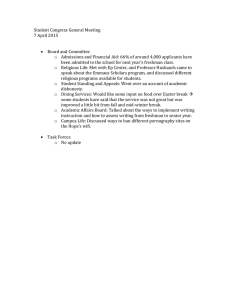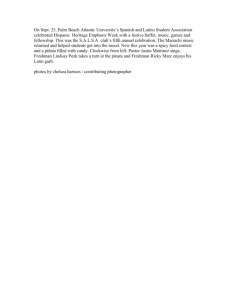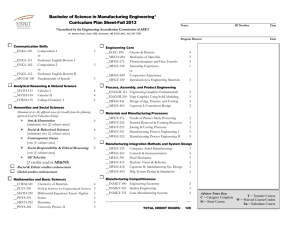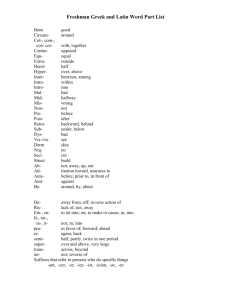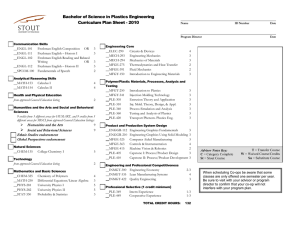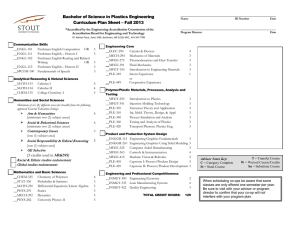What do Seniors Remember From Freshman Physics? Please share
advertisement
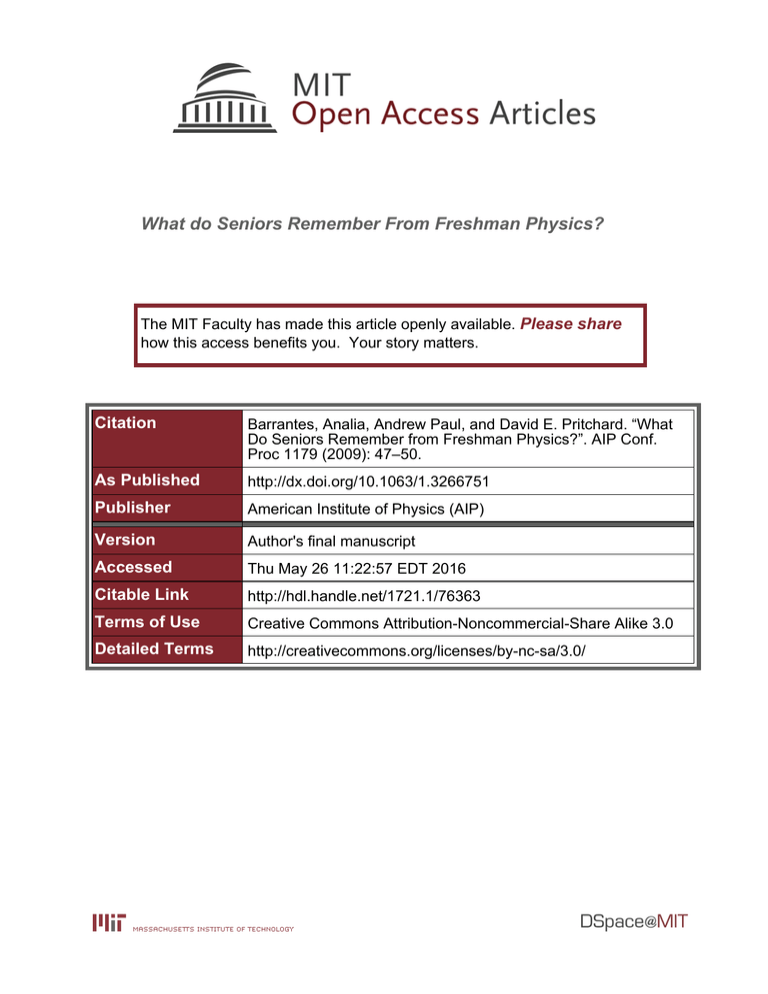
What do Seniors Remember From Freshman Physics? The MIT Faculty has made this article openly available. Please share how this access benefits you. Your story matters. Citation Barrantes, Analia, Andrew Paul, and David E. Pritchard. “What Do Seniors Remember from Freshman Physics?”. AIP Conf. Proc 1179 (2009): 47–50. As Published http://dx.doi.org/10.1063/1.3266751 Publisher American Institute of Physics (AIP) Version Author's final manuscript Accessed Thu May 26 11:22:57 EDT 2016 Citable Link http://hdl.handle.net/1721.1/76363 Terms of Use Creative Commons Attribution-Noncommercial-Share Alike 3.0 Detailed Terms http://creativecommons.org/licenses/by-nc-sa/3.0/ What do Seniors Remember from Freshman Physics? Analia Barrantes, Andrew Pawl and David E. Pritchard Physics Department, Massachusetts Institute of Technology, Cambridge, MA 02139 Abstract. We have given a group of 56 MIT seniors who took mechanics as freshmen a written test similar to the final exam they took in their freshman course, plus the Mechanics Baseline Test (MBT) and Colorado Learning Attitudes about Science Survey (C-LASS) standard instruments. Students in majors unrelated to physics scored 60% lower on the written analytic part of the final than they did as freshmen. The mean score of all students on conceptual multiple choice questions included on the final declined by approximately 50% relative to the scores of freshmen. The mean score of all participants on the MBT was insignificantly changed from the posttest taken as freshmen. More specifically, however, the students’ performance on 9 of the 26 MBT items (with 6 of the 9 involving graphical kinematics) represents a gain over their freshman pretest score (a normalized gain of about 70%, double the gain achieved in the freshman course alone), while their performance on the remaining 17 questions is best characterized as a loss of approximately 50% of the material learned in the freshman course. Attitudinal survey results indicate that almost half the seniors feel the specific mechanics course content is unlikely to be useful to them, a significant majority (75 − 85%) feel that physics does teach valuable skills, and an overwhelming majority believe that mechanics should remain a required course at MIT. Keywords: physics education research, introductory physics, course evaluation, knowledge retention, longitudinal study PACS: 01.40.Di, 01.40.Fk INTRODUCTION We have studied the physics knowledge of graduating seniors who took introductory Newtonian mechanics (MIT course 8.01) during their freshman year. We wanted to find out what is retained (or even improved), whether conceptual learning is retained better than analytic learning, and whether forgetting seems to be based on what was known at the end of 8.01 or on what was learned during 8.01. We also wanted to investigate what aspects of the students’ subsequent behavior (e.g. their major, participation in tutoring for 8.01, etc.) influenced retention. Finally, we administered the C-LASS [1] to check for changes in attitudes toward learning science. SAMPLE AND PROCEDURE Our sample consisted of students who took and passed the regular freshman mechanics course in the fall of 2005, and who were still enrolled at MIT in spring 2009. Students were recruited by email and informed that they would be retaking a final exam from a standard freshman course, but not told that the subject was physics. Students were guaranteed $75 for spending at least 3 hours on the materials and offered a 1/3 chance of receiving a performance-based award of an additional $100. A total of 56 students out of 486 invited participated in the retest. The breakdown of the participants by freshman course grade was a good approximation to the distribution for all 506 students who took the mechanics course in fall 2005 (p = 0.94 for different distributions when binned by letter grade). The students were given essentially unlimited time to complete the test materials, which consisted of: • • • • An 18 question demographic survey (∼ 15 min.). The C-LASS [1] standard survey (∼ 10 min.). The MBT [2] standard mechanics test (∼ 45 min.). A final exam comprised of 7 multiple choice and 4 written problems (∼ 2 − 3 hours). One goal of this study was to compare the retention of the mechanics curriculum in various courses of study. To gain statistical leverage, we classified the majors into three groups. Group 1 encompassed majors that were least likely to use or review the content of freshman mechanics, and Group 3 included those most likely to use mechanics. The final list of majors for each group is shown in Table 1. TABLE 1. Grouping of majors according to utilization of mechanics. N is the number of participants from each group. Included Majors N Biological Engineering, Biology, Brain and Cognitive Sciences, Civil and EnviGroup 1 26 ronmental Engineering, Literature, Management, Mathematics, Political Science Chemical Engineering, Economics, Electrical Engineering and Computer Group 2 21 Science, Materials Science and Engineering Aeronautics and Astronautics, MechaniGroup 3 9 cal Engineering, Physics e 60 Group 3 Group 2 Group 1 40 Analytic Only 20 0 Fo rgo tE ve ryt hin gB ou nd ary Fit to Group 1 Data Only 0 20 40 60 80 100 120 140 Renormalized 2005 Final Exam Score Analytic Only students) we have plotted the major groups with different symbols. The Group 1 students, who were least likely to review the mechanics content in their coursework, exhibit significant correlation between their fall 2005 score and their score shift (r = −0.81 for 26 students). The Group 1 students define the line in Fig. 1, which has a slope of −0.61 ± 0.10 with the intercept pegged at zero. Essentially, students who were unlikely to use mechanics subsequently lose 60% of the knowledge they acquired in their freshman course over the following seven semesters at MIT. None of the Group 1 students exceeded their freshman performance on the written questions, while one of the 21 Group 2 students and five of the nine Group 3 students scored better on the retest than their renormalized freshman final exam score. 50% Lost on Advanced Concepts FIGURE 1. Score shift between the end of freshman mechanics and the end of senior year on analytic problems versus freshman performance. The fit to the Group 1 data (solid line, x-intercept pegged to zero) indicates knowledge loss of 0.61 ± 0.10 in the seven semesters since taking mechanics. The dashed lines are the 1σ error bounds for the fit. The dotted line is the boundary corresponding to a score of zero on the retest. RESULTS 60% Lost on Analytic Final Exam Problems We have chosen to compare the various portions of the test independently. We begin with the questions requiring written analytic responses. The retest given to the seniors was different from the test given in 2005, though all questions were taken verbatim from MIT course 8.01 final exams. To allow for a comparison of the students’ scores on different exams, we assumed that the ability distribution of MIT freshmen classes is consistent. This assumption implies that we can generate a renormalized score on the freshman mechanics final taken in 2005 using the z-scores achieved by our study participants as freshmen (z2005 ). To do this, we generated a mean (µ2009 ) and standard deviation (σ2009 ) for the senior retest using results from the administration of the questions to freshman on their regular course final exams. The renormalized score (s2005 ) was then calculated using the formula: s2005 = z2005 σ2009 + µ2009 (1) Because the retest had a higher mean score than the 2005 exam, some of the renormalized scores exceeded 100. A plot of the shift (score achieved on the analytic questions on the retest minus the renormalized score achieved on the analytic portion of the fall 2005 final exam) versus the renormalized fall 2005 analytic problem score is shown in Fig. 1. Because there is a significant correlation between major group and performance (r = 0.58 for 56 The final exam contained seven multiple-choice conceptual questions dealing with advanced concepts like angular acceleration, angular momentum and oscillations. The retest students did not answer questions of this type on their final in 2005, but five of the seven questions selected were taken from final exams given in the same course in subsequent years. Table 2 shows that the seniors perform 50% worse than freshmen on these questions. (55% ± 13% lost for Group 1 majors alone.) TABLE 2. Performance of seniors and (different) freshmen on five multiple-choice questions covering advanced topics. Seniors Freshmen Loss Question Q1: Linear and an41(9)% gular acceleration of 43(7)% 73(2)% puck pulled by string. Q2: Internal forces al55(10)% ways conserve system 29(6)% 63(3)% momentum. Q3: Angular momentum of a translating 48(6)% 66(3)% 27(10)% point particle. Q4: Period of mass49(11)% on-spring varies with 32(6)% 63(3)% square-root of mass. Q7: Solid cylinder beats hollow cylinder 11(4)% 61(3)% 82(9)% down a ramp. 32(6)% 65(2)% 51(9)% Overall Gain and Loss on the MBT The mean score among the retest participants on the MBT was 17.6 ± 0.5 as seniors versus 17.1 ± 0.5 as (post-instruction) freshmen. These scores are essentially equal, giving no indication of knowledge loss, independent of major group. This result is misleading, however, because it obscures evidence of significant improvement on nine questions of the MBT (summarized in Table 3). Our data suggests the division of the MBT into two sepa- TABLE 3. The MBT questions assigned to Subtest A. These 9 questions showed evidence of improvement by the seniors relative to their freshman posttest scores. Subtest A∗ of the MBT Questions Topic 1,2,3,23,24,25 Graphical Kinematics 13,14 1-D Equilibrium 19 2-D Vector Addition All 17 remaining questions were assigned to Subtest B 9 48 Students Linear Fit 6 Course Gain 3 0 0 8 5 10 15 Freshman Pretest Score MBT Subtest B 48 Students* Linear Fit 6 Course Gain FIGURE 3. Score shift over 4 years on Subtest B of the MBT versus pre-score. The fit (solid line, x-intercept pegged to 17) shows a normalized gain of 0.16 ± 0.14 over a 4-year MIT career. The lower 1σ error bound to the fit is shown dashed (the upper bound is suppressed because it overlays the course gain). The dash-dotted line is the gain curve for the students during freshman mechanics (slope −0.29). 4 2 0 0 1 2 3 4 5 6 7 Freshman Pretest Score MBT Subtest A 8 9 *We lacked freshman MBT data for 8 of 56 participants. FIGURE 2. Score shift over 4 years on Subtest A of the MBT versus pre-score. The fit (solid line, x-intercept pegged to 9) implies a normalized gain of 0.69 ± 0.08 over a 4-year MIT career. The 1σ error bounds on the fit are dashed. The dash-dotted line is the gain curve for the retest students during freshman mechanics (slope −0.35). Fig. 2 shows a very strong correlation between the students’ score shifts on the nine-question Subtest A over their four years at MIT (senior retest score minus freshman pretest score) and their original freshman pretest scores (r = −0.86 for 48 students). The fit line shown in Fig. 2 implies an overall normalized gain of 0.69 ± 0.08 over four years (versus 0.35 during their freshman course). This suggests that the material covered by the nine questions of Subtest A is sufficiently ubiquitous in the MIT curriculum that all students, regardless of major, master it during their MIT careers. Fig. 3 shows that the students’ score shifts on the 17question Subtest B over their four years at MIT are not well correlated with their pretest score (r = −0.21 for 48 students). The fit shown in Fig. 3 implies a normalized gain of 0.16 ± 0.14 over the full four-year MIT career, which is lower than the normalized gain of 0.29 achieved in the one-semester mechanics course. A more insightful way to look at this knowledge loss is to consider a student’s score shift from freshman 3.5 Year Score Shift, MBT Subtest B (Freshman Posttest to Senior Retest) 4 Year Score Shift, MBT Subtest A (Freshman Pretest to Senior Retest) ∗ 4 Year Score Shift, MBT Subtest B (Freshman Pretest to Senior Retest) rate subtests, with Subtest A consisting of the nine questions showing evidence of improvement and Subtest B made up of the remaining 17 questions. 8 6 4 2 0 0 2 4 6 8 10 12 Freshman Course Score Shift, MBT Subtest B (Freshman Pretest to Freshman Posttest) FIGURE 4. Score shift from freshman posttest to senior retest on Subtest B of the MBT versus shift during the freshman class. The best fit (solid line, intercept pegged to zero) indicates a fractional loss of 0.52 ± 0.12 of the gains made during the freshman course. (1σ error bounds dashed.) posttest to the retest as a function of the score shift during the freshman course (freshman posttest minus freshman pretest). Fig. 4 shows that these two shifts exhibit a strong correlation (r = −0.59 for 48 students), indicating that in the seven semesters since finishing mechanics the students lose approximately 50% of what they learned about the 17 questions of Subtest B during the course. 100% TABLE 5. Responses to C-LASS statements 14 and 30. % Favorable % Unfavorable Statement 2005 2009 2005 2009 I study physics to learn knowledge that 38(8) 20(6) 23(7) 44(9) will be useful in my life outside of school. Reasoning skills used to understand physics 58(9) 85(5) 8(4) 5(3) can be helpful to me in my everyday life. Curiously, the Personal Interest category shifts toward unfavorable responses while the Real World Connection shifts toward favorable. Looking at the statements making up these categories, we find that the students draw a distinction between the factual content of the mechanics course and the general reasoning skills that are taught. Both the C-LASS and our own survey suggest that the students find the general skills more valuable than the factual content, and the C-LASS indicates that this attitude becomes more pronounced during their four years of undergraduate education (Tables 5 and 6, Fig. 5). TABLE 6. Responses to questions on the demographic survey. Course 8.01 is freshman mechanics. Question % Yes % No Do you think the material taught in 8.01 54(9) 46(9) will be useful to you after graduating? Do you feel 8.01 should be a required 93(4) 7(4) course for students in your major? Group 1 Group 2 Group 3 80% 60% 40% 20% 0% es m ot io n en er gy m om en tu m ro ta t gy ion ro sc op e or b os its ci pr lla ob tio le ns m so lv in g TABLE 4. C-LASS categories exhibiting significant shifts over four years. Significant shifts are shown in bold. % Favorable % Unfavorable Category 2005 2009 2005 2009 Personal Interest 51(4) 50(4) 17(3) 27(4) Real World Connec52(4) 68(3) 18(3) 20(3) tion Sense Making and 68(4) 65(3) 8(2) 18(3) Effort All Students fo rc Student attitudes were measured by the C-LASS standard instrument and also by questions on a demographic survey generated by us. The C-LASS was previously administered to the students as they entered their freshman course in 2005. Three categories exhibited significant shifts (Table 4). % Responding Useful STUDENT ATTITUDES Topic FIGURE 5. Frequency with which various topics taught in mechanics were circled as “useful to you since taking [mechanics]” by students on the demographic survey. students in all majors forgot about 50% of what they learned in their freshman course, rather than losing a percentage of what they knew entering or leaving the course. Students not majoring in physical sciences or engineering lost about 60% of the knowledge measured by analytic mechanics problems, whereas over half of the students majoring in subjects that use mechanics demonstrated improved performance on these problems. The performance of the seniors on multiple choice questions covering advanced concepts like angular dynamics suggests they have forgotten 50-55% of the knowledge they acquired on these topics during their freshman course. These findings can be summarized: you will forget about 55% of what you know on the final exam by the time you graduate, unless you use it again. During their undergraduate education, the students’ attitudes evolved to increasingly value the reasoning and problem solving skills taught in physics, but place lesser value on mechanics concepts as relevant to their everyday lives. ACKNOWLEDGMENTS This research was supported by a grant from the NSF. CONCLUSIONS On the MBT, students in all majors exhibit further learning of general skills like understanding graphs and the calculus of kinematics. On these topics the students had a normalized gain of 35% in their freshman course and almost 70% by graduation, as measured from their scores as incoming freshmen. The results on the remaining topics of the MBT are best described by the conclusion that REFERENCES 1. W. K. Adams, K. K. Perkins, N. S. Podolefsky, M. Dubson, N. D. Finkelstein and C. E. Wieman, “New instrument for measuring student beliefs about physics and learning physics: The Colorado Learning Attitudes about Science Survey,” Phys. Rev. ST-PER 2, 010101 (2006). 2. D. Hestenes and M. Wells, “A Mechanics Baseline Test”, Phys. Teach. 30, 159-165 (1992).
